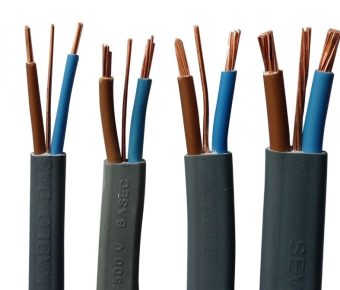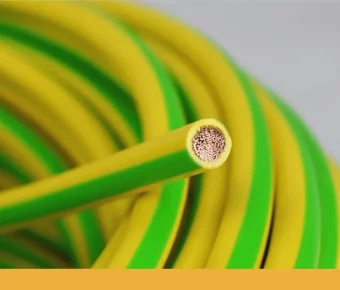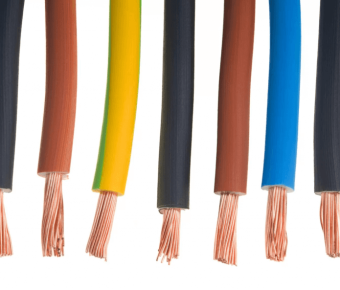- Leading Cable and Wire Manufacturer-ZW
- Twin and Earth Cable
Twin and Earth Cable
- According to IEC and BS
- PVC
- Approved by IEC, BS
- 1mm2 to 2.5mm2: Class 1 Solid Copper
4mm2 to 16mm2: Class 2 Stranded Copper
Twin and earth cable is known as twin flat cable. The voltage of the wires is 450/750v. It is suitable to use household, power plants, and instruments.
| VOLTAGE | 300/500V | |
| CONDUCTOR | 1mm2 to 2.5mm2: Class 1 Solid Copper | 1mm2 to 2.5mm2: Class 1 Solid Copper |
| CIRCUIT PROTECTIVE CONDUCTOR | 1mm2 to 2.5mm2: Class 1 Solid Copper | |
| INSULATION | PVC (Polyvinyl Chloride) | XLPE (Cross-Linked Polyethylene) |
| OUTER SHEATH | PVC (Polyvinyl Chloride) | LSZH (Low Smoke Zero Halogen) |
Conductor: solid conductor class 1 and class 2
Insulation: PVC
Sheath: PVC
Package: 100 meters
Twin and earth cable Size
Twin and Earth Cable: The Ultimate Free Professional Cable Selection Advice
The twin and earth cable is arguably the most prevalent option for domestic wiring applications. Typically, it comes in handy when dealing with a plethora of home wiring applications pertaining to fixed cabling installations in both dry and wet sites. Most local wiring regulations permit free air installations when dealing with this cable. However, it would be best to lay the cable in a tray or a conduit in sites prone to mechanical hazards. Sometimes we also call it flat cable.
Even though the twin and earth electrical cable is pretty popular, there are certain things you ought to know before buying it. For instance, you need to know the specific needs of your application including the voltage and cable length requirements. Usually, cables can be bought in a variety of sizes. Choosing the wrong cable size has serious implications such as a short circuit and fire, in a worst-case scenario. Therefore, there is no room for error when making a twin and earth cable specification selection.
Fortunately, you are in the right place if you intend to buy this cable time. This post provides free professional cable selection advice. It contains vital information on several important aspects including twin and earth cable sizes and prices, to name a few. All you need to do is sit back, relax, and read.
What is twin and earth cable used for?
It is often difficult to understand what something does if you cannot define it. So, a twin and earth electrical cable is flex mains electricity supply cable. Characteristically, it consists of three copper conductors. Two of the conductors are individually insulated and equipped to transmit electrical current whereas, the third one is an uninsulated protective conductor.
It is often applicable in domestic wiring applications. More specifically, it is suitable for fixed cable installations, for example, power supply wiring for sockets, lighting installations, and switches. It is also worth noting that this cable type is applicable in smoke alarm wiring applications. Nevertheless, there are some critical differences between a twin and earth cable for lighting and a smoke-rated one. An ideal cable for smoke alarm wiring applications must impede the production of toxic fumes when subjected to fire. This feature makes it easier for people to escape unhurt in case a building catches fire.
In general, the twin and earth cable is suitable for applications with voltage ratings ranging between 300 to 500 volts. However, the cable’s current carrying capacity varies depending on its size. For example, the current rating of a 2.5 mm twin and earth cable is 20 to 23 amperes. On the other hand, a 10mm twin and earth cable has a current rating of 44 to 52 amperes. That said, these current ratings may vary depending on the cable’s overall quality.
What is twin and earth cable made of?
This cable consists of three conductors therefore it is safe to call it a 3 core twin cable. Its conductors are made of copper material and occur in two different forms namely, the stranded and solid wire. The 2.5 mm, 1.5 mm, and 1 mm options are generally made of solid copper conductors. In contrast, the 4mm, 6mm, 10mm earth cable, and 6mm twin and earth cables consist of 7 strand conductors.
Two of the twin and earth cable’s conductors have insulation made of Polyvinyl Chloride (PVC). The twin-core insulations have color codes representing the live and neutral wires. According to the modern harmonized color code, the twin brown and earth cable represents the live conductor. Usually, the blue twin insulation represents the neutral conductor.
Still, if you are dealing with old installations from the 1950s and 60s you might come across a black twin and earth cable. In the past, the black color was a representation of the neutral twin wire. Also, the central protective circuit wire, also known as the earth wire is made of pure copper without any insulation. The twin and earth cable consists of an outer sheath that is also made of top-grade Polyvinyl Chloride. Still, it is wise to remember that the cable’s outer sheath is not UV-resistant. Consequently, you should avoid using it for outdoor applications that might expose it to sunlight.
What size of twin and earth cable is ideal for lighting?
A considerable proportion of your indoor electrical wires consist of twin and earth electrical cables. Nevertheless, there are different forms of wiring within a home environment that require different types of cables. Common wiring applications in a home environment include switch wiring, sockets, and lighting fixtures. Each of these applications requires a specific twin cable size depending on the voltage requirements. Lighting is the most prevalent home wiring application. So, do you know the ideal size of twin and earth electrical cables for lighting applications?
Most people assume that the answer to that question is straightforward but unfortunately, it is not. You have to consider several factors when choosing the ideal size for your lighting applications. Generally, twin core cable comes in handy for lighting applications. However, if you are dealing with long circuits, it would be best to use a 1.5mm2 twin and earth cable to account for the voltage drop.
How to measure twin and earth cable?
Usually, manufacturers indicate the size of the cable on its outer sheath so you do not necessarily need to measure it. Nevertheless, some people may feel the need to measure a twin and earth cable to ensure that the measurements are accurate. So, how exactly should you measure it?
First, you need to procure a reliable measurement device. Using the device, clamp both ends of the cable’s diameter and move it until you find a perfectly fitting position. Once you find the ideal spot, read the measurement shown on the device for the electrical cable twin and earth diameter.
Can you use twin and earth cable outside?
This cable type is best suited for in-house wiring but you can use it outside provided you replace it regularly. More importantly, there are certain things you ought to know if you decide to use this cable type outside. First, you need to check your local wiring regulations to ensure that they permit the outdoor installation of twin and earth cables. You should also avoid buying cheap twin and earth cables because cheap often translates to low-quality products. It would be wise to consider the cable’s quality and functionality rather than the twin and earth cable prices.
People have used a twin and earth cable for exterior installations for years without any dire consequences. However, you have to shield the cable against Ultra-violet rays and mechanical hazards. This cable type is extremely durable provided you choose the right quality for your application and perform the installation appropriately.





